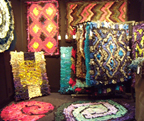I resisted dyeing yarn and fiber because I didn’t want to get into disposing of chemicals in a house with a septic field. Recently, I discovered that food coloring could be used to dye protein fiber (wool), and my color world changed. I’m in the Shave ‘Em to Save ‘Em program from the Livestock Conservancy. I need to make something from the fiber from 15 different breeds of sheep, and some of the sheep only produce white wool (others come in up to 11 colors). That’s more white than will work in my life.
I decided to start by dyeing some roving of unknown fiber and origin that had been in my stash for several years. I found it in a bag at the Thrift Shop and used the red and blue to make Monkey Paw knots as part of my wedding decorations. Hadn’t found a use for the white roving until now. The fiber is a little compressed from storage, but with predrafting, spins well enough.
I wet an ounce of fiber in a food storage container, and dropped red, yellow, and neon pink food coloring directly onto the fiber. I mushed the coloring around a bit, and then added water to help it move.
I wasn’t sure how far or fast the food coloring would move, or even how much to use, and I hadn’t watched any videos at this point. I put the roving through several cycles of heating in the microwave for two minutes, cooling, and heating again, until the water started to clear.
The pink disappeared immediately, and the yellow was overtaken by the red before long. There is a slight trace of orange in the final yarn after spinning.
Clear water indicated that the dye was striking and being absorbed into the fiber. When it was completely cool, I rinsed the fiber, dried it, and spun it the next day. Then I set the spun yarn by wetting it again and will play with it when the blue yarn is finished.
When I finished with the red, I tried again with green, turquoise, and blue (regular blue and neon blue), using much less water. I wanted colors that were more distinct.
I forgot to take pictures after adding the dye in the first step. The color took forever to strike–probably not enough vinegar. I used very little water, and not-much-water boiled very quickly in the microwave so I needed to intervene and stop the heating cycle.
After a few cycles, I realized it would help if I turned the roving over so the dye could work on the pale upper side.
It wasn’t completely done, but I was, so I stopped the process, rinsed the fiber, and let it dry.
I am less than thrilled with the results, but I did get more color differentiation than the red. When I was done with the green sample, I sat and watched dyeing videos from ChemKnits for the rest of the afternoon and learned more about how to dye fiber with food coloring.
This is how the green turned out. I plied it wrong (Z twist, with Z twist singles) and am waiting to see what happens when I soak it in water.















